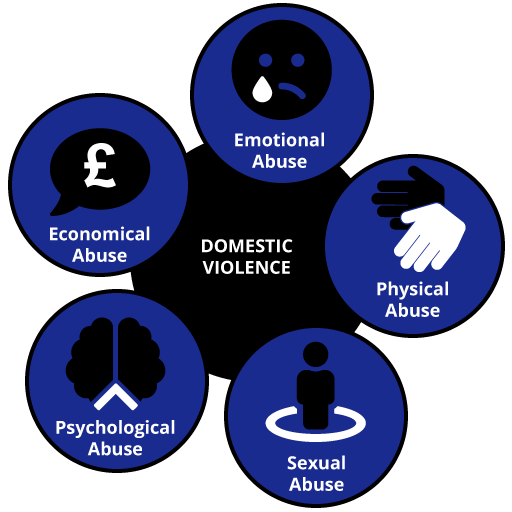2.2 What is domestic abuse?
Activity 1
In the first training module you looked at what domestic abuse is. Thinking about all you have learnt so far and your previous experience, what do you think domestic abuse is?
Comment
Having considered the definition of domestic abuse in the first training module, we expect most of you would be able to give a good definition of domestic abuse. You may recall that there are two elements to domestic abuse; an intimate or family relationship and abusive behaviours. This may include psychological, physical, sexual, financial or emotional abuse. You may also have considered the fact that this behaviour may be one off or a pattern of behaviour.
You may also have thought about coercive and controlling behaviour, which was introduced in the first training module. This is behaviour where the perpetrator isolates and controls the survivor or behaves in a way to punish or intimidate the survivor.
We are now going to look at our case study, the Johnson/Smith family. Remind yourself of the family and their situation.
In our case study, Jazmin Johnson has left her former partner Steve Smith and found emergency accommodation for herself and her two children. A member of staff from the refuge has suggested she should apply for a
Activity 2
Would you consider Jazmin to have experienced domestic abuse and why (or why not)?
Comment
Jazmin has experienced domestic abuse from Steve. They were in an intimate relationship for five years. She has experienced abusive behaviour including physical violence (when he punched her in the face), financial abuse (controlling the money and not giving her sufficient money for food and care of her children) and emotional abuse (isolating her from her friends, being angry when she did not do as he wants).
In the first domestic abuse module, we considered one specific form of domestic abuse – coercive control. Here is a reminder of the definitions of coercive and controlling behaviour provided in the first training module:
Controlling behaviour
Controlling behaviour is a range of acts designed to make a person subordinate and/or dependent by isolating them from sources of support, exploiting their resources and capacities for personal gain, depriving them of the means needed for independence, resistance and escape and regulating their everyday behaviour.
Coercive behaviour
Coercive behaviour is an act or a pattern of acts of assault, threats, humiliation and intimidation or other abuse that is used to harm, punish, or frighten their victim
Coercive and controlling behaviour is due to a power imbalance in the relationship, where the perpetrator is acting to ensure he has all the power and control in the relationship. If you were to speak to an abusive partner they would probably not describe the aim of their behaviours as seeking power and control over their partner. They are more likely to talk about aspects of their partner or their behaviour that they dislike or would like to change. Nevertheless the root lies in a quest for power and control.
Activity 3
What types of behaviour are typically associated with coercive and controlling behaviour?
Comment
You may recall from the first domestic abuse module that we looked at a diagram which illustrates the types of behaviour that perpetrators use to gain power and control over their partner. This diagram is called the Duluth Power and Control Wheel.
Hover over each segment of the wheel below to display the full definitions.
The tactics described above usually are used together. If one doesn’t work, the perpetrator may use a different one or more than one. It is systematic and is done by choice with the intention of controlling the survivor and preventing their freedom of choice and action.
Understanding the different forms domestic abuse can take, the importance of power and control in coercive control and the different tactics perpetrators can use will help you understand and support domestic abuse survivors better. We will look at ways you can support clients who have experienced domestic abuse in more detail below.
Activity 4
Please answer the following multiple choice questions. There is one correct answer for each question.
a.
True
b.
False
The correct answer is a.
Answer
The correct answer is True. Although we have focused on intimate relationships between partners, abusive behaviours within familial relationships can also be domestic abuse.
a.
True
b.
False
The correct answer is a.
Answer
The correct answer is True. Whilst each of the suggested acts may be in isolation a loving or supportive act, in the context of a pattern of behaviour they can be evidence of controlling behaviour which seeks to isolate the survivor and take away her ability to make independent choices.
a.
True
b.
False
The correct answer is b.
Answer
The correct answer is False. Whilst some perpetrators may have vulnerabilities such as substance misuse or anger management issues, these do not cause coercive or controlling behaviour. The perpetrator is making a decision to act in this way to exert power and control in the relationship.
a.
True
b.
False
The correct answer is b.
Answer
The correct answer is False. Whilst violent acts could be evidence of controlling behaviour, sometimes coercive and controlling relationships do not involve any actual violence. A more reliable method of identifying coercive and controlling behaviour is to consider the client’s human rights and whether her ability to make her own choices in her personal, social, economic and political life is being limited by the perpetrator’s actions.
a.
True
b.
False
The correct answer is a.
Answer
The correct answer is True. We have used ‘he’ to refer to the perpetrator and ‘she’ to refer to the survivor of domestic abuse, as this is the scenario you will most commonly come across in your volunteering. However it is important to remember that men can also be survivors of domestic abuse including coercive and controlling behaviours. This may be in a heterosexual or same sex relationships. Support Through Court supports all individuals who come into their office and you should be considering whether domestic abuse and coercive and controlling behaviour may be involved for any clients you support, regardless of gender or sexual orientation.
2.1 Introduction

